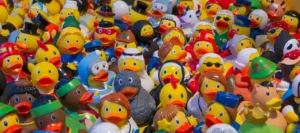From water bottles to car parts to medical machinery, plastics make the world go round. Despite all we hear about reducing plastic consumption and about how plastic is everywhere, how much do you really know about this material?
Do you know what plastic is? Where does plastic come from? How it’s made?
Probably not. You’re in luck though: we’re going to give you the scoop on plastic 7 interesting facts
1. What Is Plastic? Where Does Plastic Come from?
Plastics are types of polymers. A polymer is essentially a long chain of repeating links all connected together, kind of like a chain.
The word “plastic” can be used to describe many different types of polymers. Some of the most common plastic types include:
- Polyethylene terephthalate
- Polypropylene
- Polystyrene
- High-density polyethylene
- Polyvinyl chloride
Notice how these names all have “poly” in them. Most plastics do since it’s referring to the polymer nature of the compound.
But where do these polymers come from? Plastic is a synthetic polymer meaning these compounds are man-made. When we say “industrial polymers,” usually we are referring to plastics synthetically made for industrial purposes like the automotive and construction industries, for example.
Plastic polymers are from materials found in oil, natural gas, and coal.
2. The Inventor of Plastic
So who was the first to create plastic? Well, nature. Rubber, which is a type of plastic, comes from the rubber tree.
Besides that, the origin of the plastic we all are familiar with, the synthetic polymers, it’s a bit more complicated. Alexander Parkes created a type of “plastic” made from cellulose (an organic material) in 1892. A few years later, John Wesley Hyatt created a similar material also out of cellulose.
However, the “official” invention of a synthetic polymer that we currently would recognize as plastic wasn’t invented until 1907. Leo Hendrik Baekeland created what he called “Bakelite”: a completely synthetic polymer that could be molded into different shapes and objects.
The full name for this first plastic was polyoxybenzylmethylenglycolanhydride. Good thing Leo was a fan of his plastic’s nickname, otherwise no one would be able to pronounce his new invention.
3. Plastic Isn’t Just for Water Bottles
Most of us are familiar with the common uses for plastics: water bottles, plastic sorting containers, grocery bags, Tupperware, etc.
But plastic has a number of uses in a number of different industries. It’s used:
- To make car parts
- To build boats/ships
- To make tennis balls
- In construction
- To insulate buildings
- In the aviation industry
- In electrical wiring
Plastic is also huge in the healthcare industry. It makes medical equipment, surgical tools, and is even being applied to create prosthetic limbs.
4. The Largest Synthetic Molecule Ever Made: A Type of Plastic
As we mentioned, plastics are a synthetic, man-made material. While we have most of the plastics we use on a daily basis, scientists are constantly trying to adjust, change, and create new synthetic molecules that can be used for new purposes.
And that’s just what the scientists at the Swiss Institute of Technology did when they created what’s now called PG5. PG5 is the largest synthetic molecule ever created by scientists in the lab. This one molecule is about the same size as a virus, which, in science-speak, is crazy big.
They didn’t just make this molecule of plastic for fun, either. Scientists believe that they can apply PG5 to a number of industries, but perhaps the most exciting application would be to healthcare.
Scientists believe that PG5 could be used to deliver medications inside the body. The medicine would fit into the myriad of folds and creases that PG5 has, which would allow the medicine to be delivered to key points in the body.
5. Plastic-Eating Fungus?
We hear a lot about how plastic takes a long time to degrade, but what if we could find an organism that likes to eat plastic? This is hard since plastics are synthetic and many natural organisms wouldn’t be able to consume or break it down.
But, scientists did discover a type of fungus that “eats” plastic. This fungus from the Amazon rainforest can break down and consume what are usually non-biodegradable plastics.
Scientists hope to harness the power of this awesome fungi to create ways to break down plastics that would normally pollute the Carth’s oceans and landfills.
6. Plastic Pollution
Unfortunately, despite all of the benefits and applications of plastics, it still is a huge problem for the environment. Plastic usually isn’t biodegradable, which means it can take thousands of years for a single plastic bottle, for example, to completely degrade.
This leads to oceans clogged with plastic waste, excess plastic materials dumped in landfills, and more plastic items being created than can be recycled. Unless we find new materials or find ways to better reduce and recycle plastics, the plants, animals, and environments of Earth are in danger.
7. Some Plastics Contain Dangerous Chemicals
Another concern that comes with plastics are the toxins within them. Plastic items that we use every day contain dangerous chemicals like:
- Phthalates
- BPA
- PVC
- Heavy metals
- Pesticides
- Polychlorinated biphenyls
Many of these chemicals have been shown to disrupt proper hormone signaling, which can lead to birth defects, early puberty, and negative neurological effects. There’s also evidence suggesting chemicals in plastic have been linked to cancer, brain abnormalities, and mental health problems.
Facts About Plastic: Final Thoughts
As you can tell, plastic has its definite pros and cons. It’s useful (and essentially required) in a number of important industries. It can be used in modern day innovations for healthcare, transportation, and more.
But there are dangers associated with plastics that we need to be aware of moving forward. That’s why it’s so good to know that scientists are working hard on discovering ways to degrade plastic products, like with the plastic-eating fungus.
If you want to learn more about reducing your use of plastics and helping the environment, check out our article on the topic.








